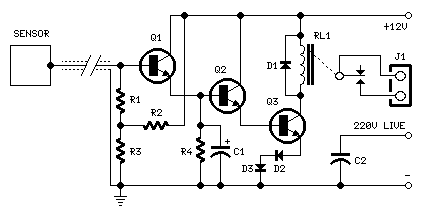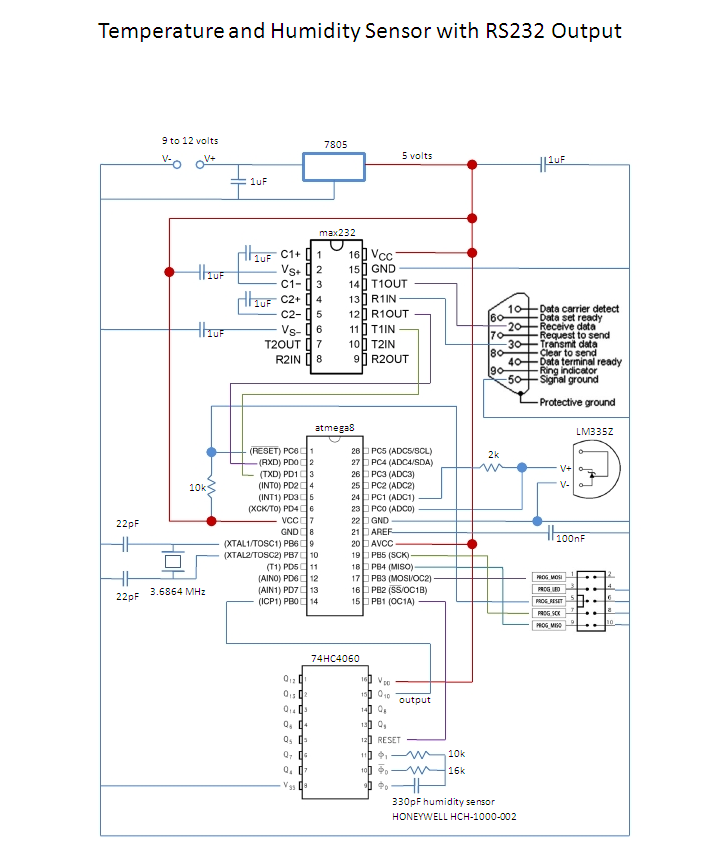
capacitive sensor

For proper operation, the circuit ground must be connected via a small-value, high-voltage-rated capacitor to one side of the mains supply socket. The "Live" side is the right one. This circuit is designed to animate shop windows using a capacitive sensor placed behind a postcard-like banner. The card is positioned against the glass in front of the shop window, allowing visitors to activate the relay by placing their hand on the card from the outside. This circuit is especially suitable for toy shops, as it can activate model trains, small electric racing cars, lights, etc. Further applications are left to the user's imagination. It can be adapted to enhance the impact of shop windows during the Christmas season. Q1, Q2, and Q3 form a high-impedance super-Darlington configuration that drives the relay, amplifying the 50 Hz alternating mains supply frequency induced in the sensor by the human body. C1, D2, and D3 ensure clean relay switching. The power supply can be any commercial wall plug-in transformer with a rectifier and smoothing capacitor, capable of supplying the necessary voltage and current to power the intended relay.
The circuit operates on the principle of capacitive sensing, which allows it to detect the presence of a human hand without direct contact. The capacitive sensor behind the banner registers changes in capacitance caused by the proximity of a hand, which is sufficient to trigger the relay. The relay serves as a switch to activate various devices, such as lights or toys, enhancing the visual appeal of the shop window.
The components Q1, Q2, and Q3 are configured in a super-Darlington arrangement, which provides high sensitivity and amplification of the signal from the capacitive sensor. This configuration is particularly advantageous for low-power applications, as it allows the circuit to respond effectively to small changes in capacitance. The use of a high-voltage-rated capacitor in the ground connection is crucial for safety, ensuring the circuit can handle potential surges from the mains supply.
Capacitor C1, along with diodes D2 and D3, is essential for ensuring that the relay switches cleanly without bouncing, which can cause erratic operation. The choice of a wall plug-in transformer for the power supply simplifies the design and enhances safety, as it isolates the circuit from the mains supply and provides a stable voltage output suitable for the relay's operation.
This circuit design presents a versatile solution for retailers looking to engage customers through interactive displays, particularly during high-traffic seasons such as Christmas. By adapting the circuit to different applications, shop owners can create unique experiences that draw attention and encourage purchases.For proper operation, circuit ground must be connected via a small value, high voltage-rating capacitor to one side of the mains supply socket. The "Live" side is the right one. The purpose of this circuit is to animate shop-windows by means of a capacitive sensor placed behind a post-card-like banner.
The card is placed against the glass in side the shop-window, and the visitor can activate the relay placing his hand on the card, from the outside. Especially suited for toy-shops, the circuit can activate model trains, small electric racing cars, lights etc.
Further applications are left at user`s imagination. Adopt it to increase the impact of your shop-window on next Christmas season! Q1, Q2 & Q3 form a high impedance super-Darlington that drives the relay, amplifying the 50Hz alternate mains-supply frequency induced in the sensor by the human body. C1 & D2, D3 ensure a clean relay`s switching. Power supply can be any commercial wall plug-in transformer with rectifier and smoothing capacitor, capable of supplying the voltage and current necessary to power the relay you intend to use.
🔗 External reference
The circuit operates on the principle of capacitive sensing, which allows it to detect the presence of a human hand without direct contact. The capacitive sensor behind the banner registers changes in capacitance caused by the proximity of a hand, which is sufficient to trigger the relay. The relay serves as a switch to activate various devices, such as lights or toys, enhancing the visual appeal of the shop window.
The components Q1, Q2, and Q3 are configured in a super-Darlington arrangement, which provides high sensitivity and amplification of the signal from the capacitive sensor. This configuration is particularly advantageous for low-power applications, as it allows the circuit to respond effectively to small changes in capacitance. The use of a high-voltage-rated capacitor in the ground connection is crucial for safety, ensuring the circuit can handle potential surges from the mains supply.
Capacitor C1, along with diodes D2 and D3, is essential for ensuring that the relay switches cleanly without bouncing, which can cause erratic operation. The choice of a wall plug-in transformer for the power supply simplifies the design and enhances safety, as it isolates the circuit from the mains supply and provides a stable voltage output suitable for the relay's operation.
This circuit design presents a versatile solution for retailers looking to engage customers through interactive displays, particularly during high-traffic seasons such as Christmas. By adapting the circuit to different applications, shop owners can create unique experiences that draw attention and encourage purchases.For proper operation, circuit ground must be connected via a small value, high voltage-rating capacitor to one side of the mains supply socket. The "Live" side is the right one. The purpose of this circuit is to animate shop-windows by means of a capacitive sensor placed behind a post-card-like banner.
The card is placed against the glass in side the shop-window, and the visitor can activate the relay placing his hand on the card, from the outside. Especially suited for toy-shops, the circuit can activate model trains, small electric racing cars, lights etc.
Further applications are left at user`s imagination. Adopt it to increase the impact of your shop-window on next Christmas season! Q1, Q2 & Q3 form a high impedance super-Darlington that drives the relay, amplifying the 50Hz alternate mains-supply frequency induced in the sensor by the human body. C1 & D2, D3 ensure a clean relay`s switching. Power supply can be any commercial wall plug-in transformer with rectifier and smoothing capacitor, capable of supplying the voltage and current necessary to power the relay you intend to use.
🔗 External reference
Warning: include(partials/cookie-banner.php): Failed to open stream: Permission denied in /var/www/html/nextgr/view-circuit.php on line 713
Warning: include(): Failed opening 'partials/cookie-banner.php' for inclusion (include_path='.:/usr/share/php') in /var/www/html/nextgr/view-circuit.php on line 713





